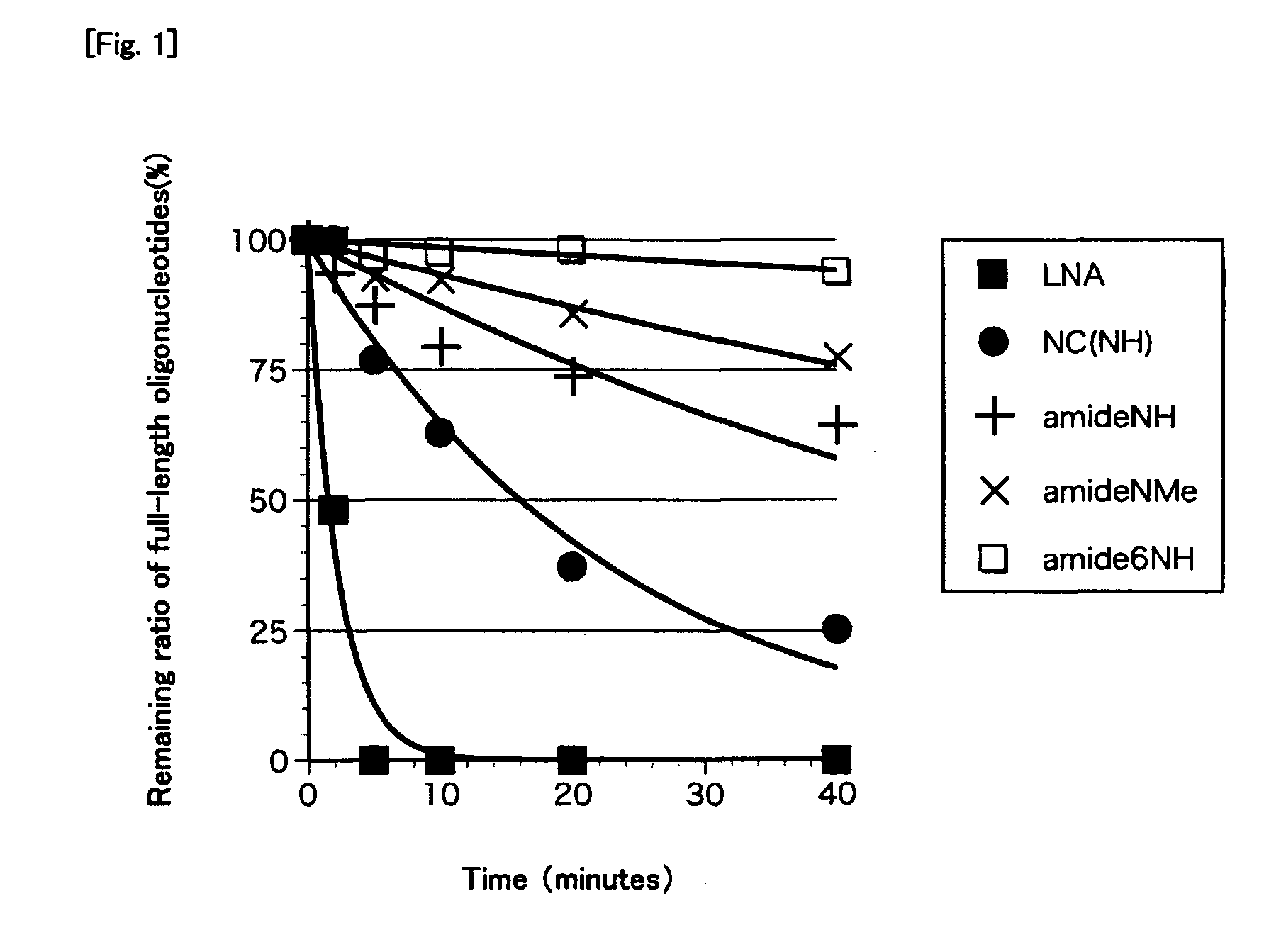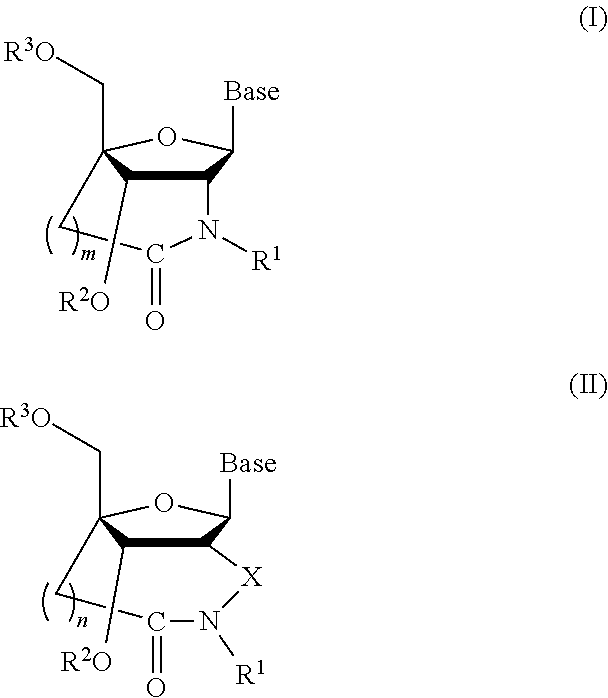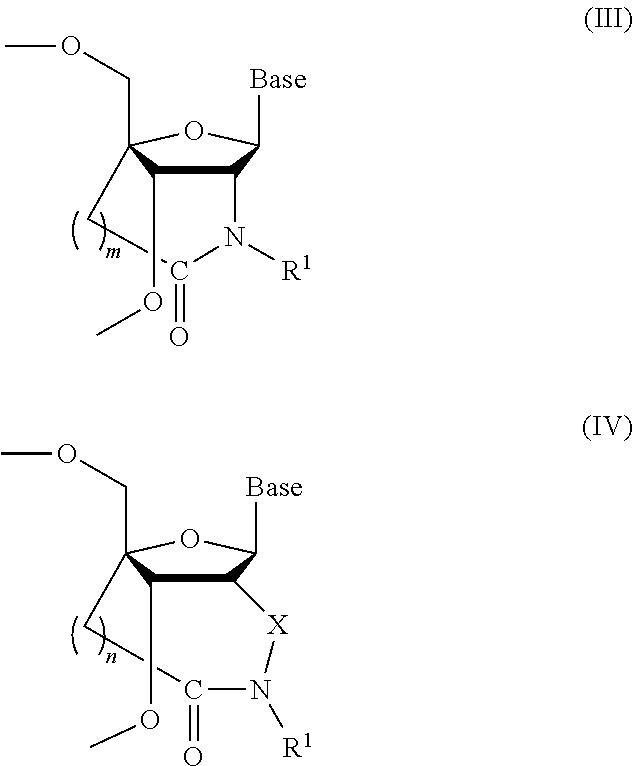Bridged artificial nucleoside and nucleotide
a technology of which is applied in the field of bridged artificial nucleosides and nucleotides, can solve the problems of not finding ideal molecules, affecting the stability the low binding affinity of the target nucleic acid strand, so as to achieve the effect of increasing the resistance of nuclease over lna
- Summary
- Abstract
- Description
- Claims
- Application Information
AI Technical Summary
Benefits of technology
Problems solved by technology
Method used
Image
Examples
example 1
Synthesis of the nucleoside analogue: 2′-amino-3′-O-[2-cyanoethoxy(diisopropylamino) phosphino]-5′O-dimethoxytrityl-2′-N,4′-C-oxomethylene thymidine (Compound 16: Amide NH)
[0083]
[0084](1) Synthesis of Compound 2
[0085]Under nitrogen stream, to a solution of compound 1 (14.7 g, 36.8 mmol) in dichloromethane (80 mL) was added triethylamine (15.1 mL, 110 mmol) followed by, under ice-cooling, dimethylaminopyridine (0.90 g, 7.36 mmol), tert-butyldiphenylsilyl chloride (15.1 mL, 58.9 mmol) and the mixture was then refluxed. Compound 1 may be prepared according to Koshkin, A. A. et al., Tetrahedron, 1998, vol. 54, pp. 3607-3630 and Singh, S. K. et al., Chem. Commun., 1998, pp. 455-456. After 20 hours, water was added to the mixture which was then extracted with methylene chloride, and the organic layer was washed with water and saturated saline and dried over anhydrous sodium sulphate. The resultant crude product was purified by silica-gel chromatography (n-hexane:ethyl acetate=9:1(v / v)) to...
example 2
Synthesis and Purification of Oligonucleotide Analogues
[0123]10mer of the oligonucleotide analogues containing compound 16 from Example 1 above (compounds 17-20: showed in Table 1 below) were synthesized using Expedite™ 8909 (from ABI) in the scale of 0.2 μmol. In this synthesis, the capping step in the standard phosphoramidite protocol was skipped. The compound 16 (amidite unit) was dissolved in tetrahydrofuran to use in the synthesis. In Table 1, the compound 16 is indicated by X. Duration of the coupling reaction between an amidite unit (compound 16) and a hydroxyl group at 5′-terminus was extended from 1.5 minutes (standard condition) to 20 minutes. The oligonucleotide analogues with 5′-terminus protected with a DMTr group supported on a solid phase were treated with 0.05 M solution of potassium carbonate in methanol and then neutralized with 5% (w / v) hydrochloric acid, after which the solvent was distilled away. The resultant crude product was partially purified by the gel filt...
example 3
Determination of the Melting Temperature (Tm)
[0126]After compounds 17-19 and 21-24 (antisense strands), which were the oligonucleotide strands synthesized in Example 2 above, and sense strands (3′-5′) were subjected to an annealing treatment, their Tm values were measured to determine the hybridization ability of the antisense strands. The Tm value means the temperature at which 50% of the double-stranded nucleic acids dissociate into single strands and the higher Tm value means the stronger binding force between the strands constituting the double-stranded nucleic acid.
[0127]The sample solution (130 μL) containing 100 mM NaCl, 10 mM sodium phosphate buffer (pH 7.2), 4 μM antisense strands and 4 μM sense strands was heated in a boiled water bath and then cooled to room temperature over 10 hours. Nitrogen stream was passed into a cell chamber of a spectrophotometer (Shimadzu, UV-1650PC) for dew condensation prevention and the sample solution was gradually cooled to 5° C. and kept at ...
PUM
| Property | Measurement | Unit |
|---|---|---|
| Fraction | aaaaa | aaaaa |
| Fraction | aaaaa | aaaaa |
| Length | aaaaa | aaaaa |
Abstract
Description
Claims
Application Information
 Login to View More
Login to View More - R&D
- Intellectual Property
- Life Sciences
- Materials
- Tech Scout
- Unparalleled Data Quality
- Higher Quality Content
- 60% Fewer Hallucinations
Browse by: Latest US Patents, China's latest patents, Technical Efficacy Thesaurus, Application Domain, Technology Topic, Popular Technical Reports.
© 2025 PatSnap. All rights reserved.Legal|Privacy policy|Modern Slavery Act Transparency Statement|Sitemap|About US| Contact US: help@patsnap.com



